What is a Personal Vision and Vision Board?
There is inside each person a clear, bright, and inspiring personal vision. This vision captures dreams, aspirations, hopes, life plans, and beyond that it articulates where you are going in life, who you are becoming, and the legacy of your life. This vision is your life calling, purpose, and motivation. Unleashed, it is powerful beyond measure!
Your vision board is the visual manifestation – the visual unleashing – of your internal vision. It’s said that a picture says a thousand words, and your vision board becomes a visual novel that captures all of your dreams, hopes, goals, aspirations, and life plans.
Why Does Your Vision Matter?
Your vision is the starting point to lead a life by design, not by default.
Without a clear personal vision, the currents and storms of life take you where they are going, not where you want to go (a life by default). Your life callings, life hopes, and aspirations get caught up and possibly drowned out in these currents. That is not for you. That is not your path. That’s why this matters.
Your vision gives you a destination in life so that you can navigate life’s storms and currents with direction, purpose, motivation, and a desire to achieve! Your vision further acts as a compass and rudder to successfully fight the currents and blinding storms that would pull you away from your destiny. Your vision – and the vision board that captures it – unleash your fullest potential, help you define and realize your life calling, and live with purpose, power, and meaning.
So, it matters greatly.


How to Develop Your Vision & Vision Board?
What do you hope for?
What do you dream of?
What do you aspire to?
What are you planning on?
What is your vision?
What are your goals?
How do you move from visionary to achiever?
Sometimes these can be difficult questions to answer and even articulate. What can you do to define, capture, and visualize your hopes, dreams, aspirations, plans, visions, and goals? What can you do to realize them?
Fortunately, there are four very simple steps to articulate your vision, find your answers to these questions, and create your vision board.
After you go through these four steps, you’ll also find a fifth bonus step that shows you how to achieve and realize your dreams and aspirations at the daily and weekly level (so that dreams and potential become a reality).
Four Steps to Your Vision Board
Step One – Write Out Your Key Life Roles
You might ask, “What’s the point of this step?” It’s the foundation and key step to discovering and articulating your inner vision, so please take a moment to thoughtfully complete this step.
Review your life and identify your current key “roles.” What is a role? A role is one of the multiple ongoing “parts” or “areas of responsibility” in your life. Below are some common examples of roles that people assume in life (people typically have 4-9 roles):
Personal
Professional (Job)
Student
Parent
Spouse or Partner
Coach or Athlete / Sport
Daughter / Son / Sibling
Investor or Entrepreneur
Church
Community or politics
Charity involvement
Friend
Your “personal role” is your most important role for one simple reason – if you do not take care of yourself, you cannot perform well in other areas of your life. If you’re not healthy and well mentally, emotionally, and physically then you significantly compromise yourself across all life roles. Think about it for a few seconds, and you’ll see the truth of that statement.
Your personal role is in fact broken into these three key areas: physical, mental, and emotional. Some people add a fourth personal component of “spiritual” as well. Some also include a “financial” component to this personal role.
So, a common “roles” list might look something like this:
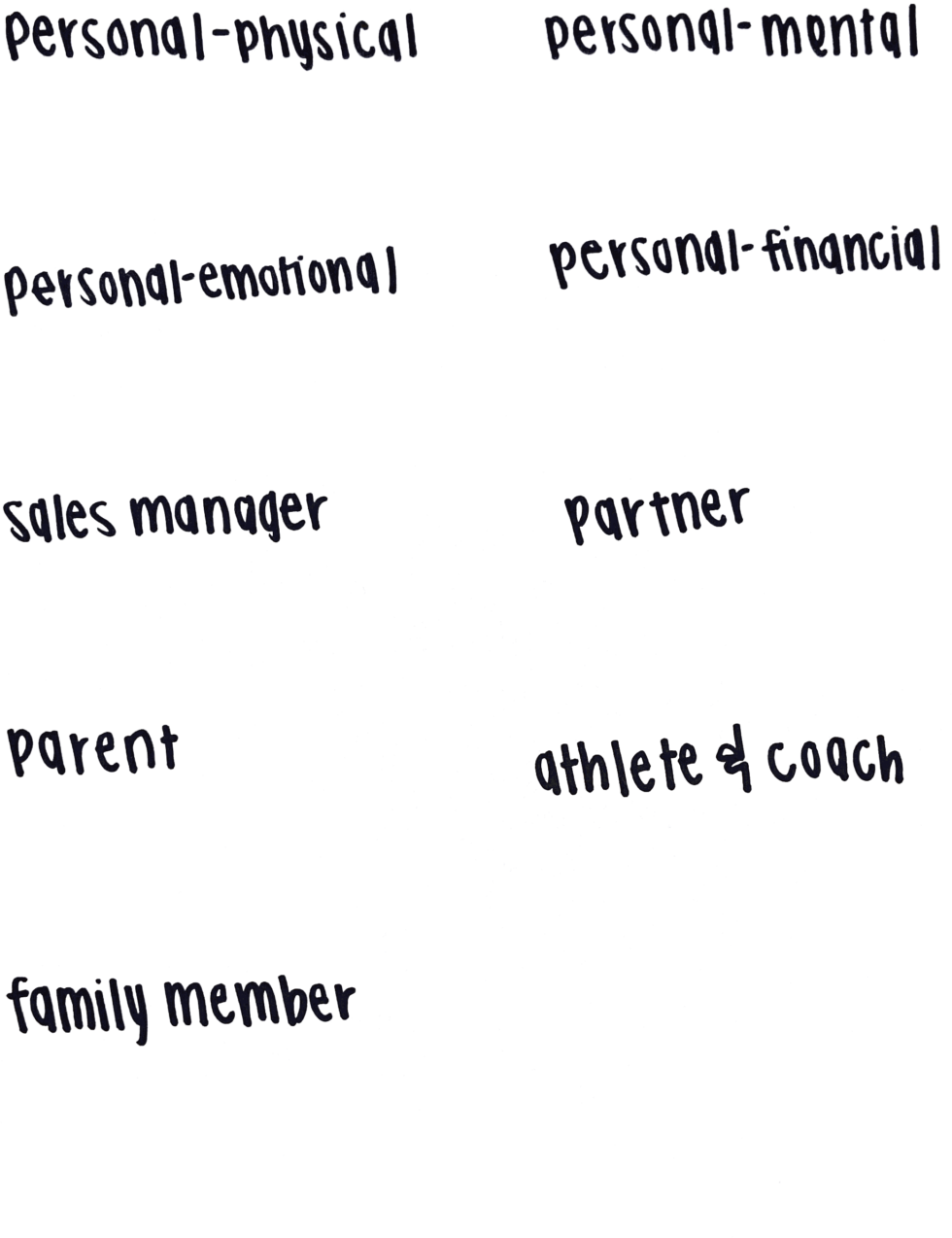
What does your roles list look like? What are your 4-9 key roles? Take a few minutes to write out your key roles, and leave a space underneath each role for the next step.
Step Two – Articulate Your Internal Vision for Each Role
For each role, write down your “ideal,” “hopes,” and your inspirational “aspirations” for each role. You write only a few words, perhaps one and no more than one or two sentences for each role. This should be concise, clear, and motivational! If it’s helpful, simply answer this questions for each role:
- How would I want others to describe me in this role?
- What is totally inspiring that I would like to accomplish for this role?
- In 10 years from now, as I look back, how do I want to see myself in this role?
Below are some examples (continuing the previously used example) of what a person might write down:
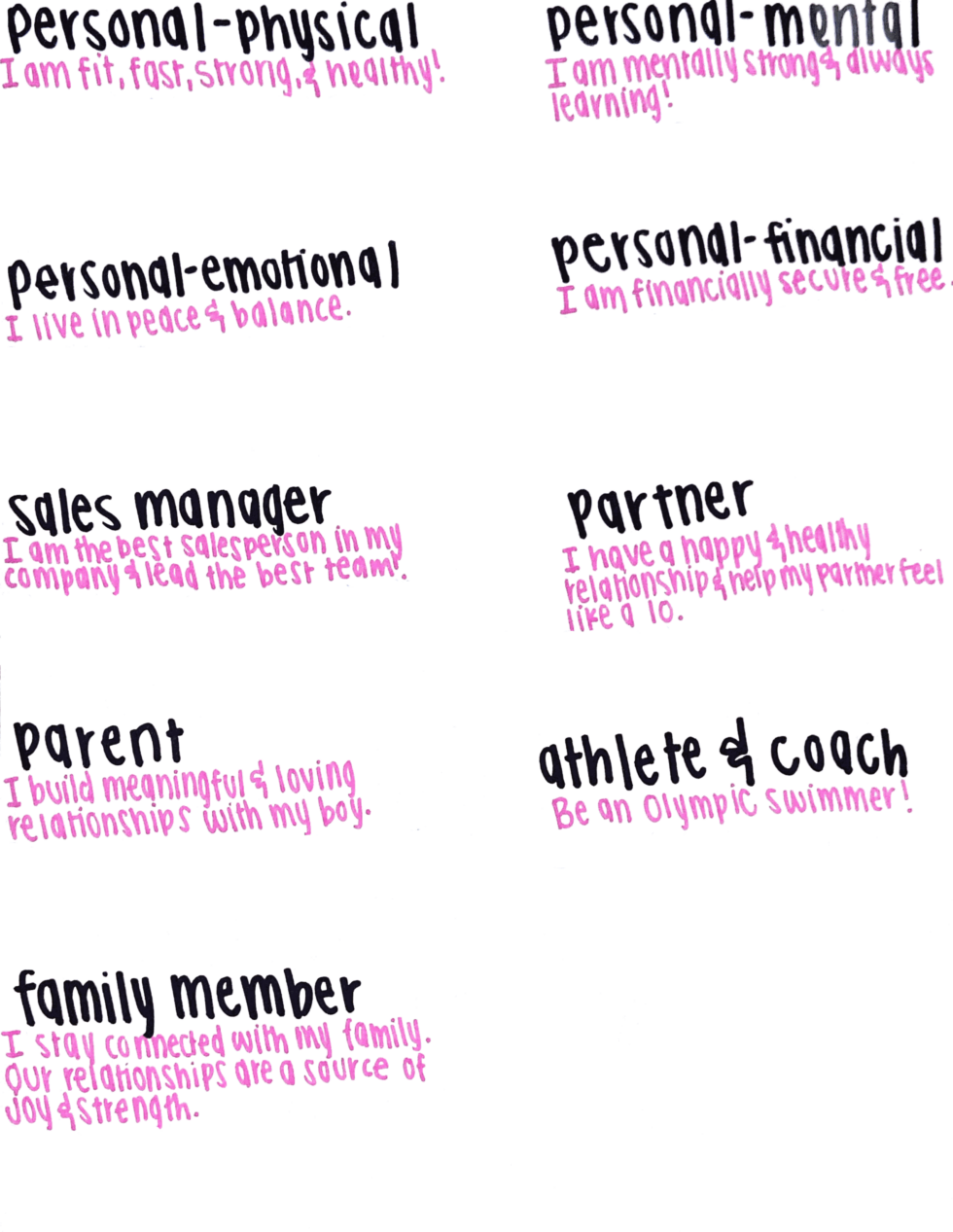
The answers to these questions, for each of your key roles, are your current internal vision! They should describe who you are, where you’re going, what you’re becoming, and your hopes and aspirations. Now, this vision might pivot or evolve over time, but this is it today! So, get it written down and pat yourself on the back for articulating it! This is the beginning of great things to come!
Step Three – Find Pictures That Capture the Essence of Your Vision for Each Role
This is where it gets creative and fun. Take a new sheet of paper, and you’re going to use this paper to design a “draft” vision board! Write down each of your roles across the paper, in whatever pattern you like. There are no rules to how you design and create this. You do you 🙂 You may write out your roles in a list, a web pattern, or a big circle – however you like. You could put them around a cardboard box and make them a vision cube. You do you 🙂
Here are two simple example layouts (continuing the previous example):
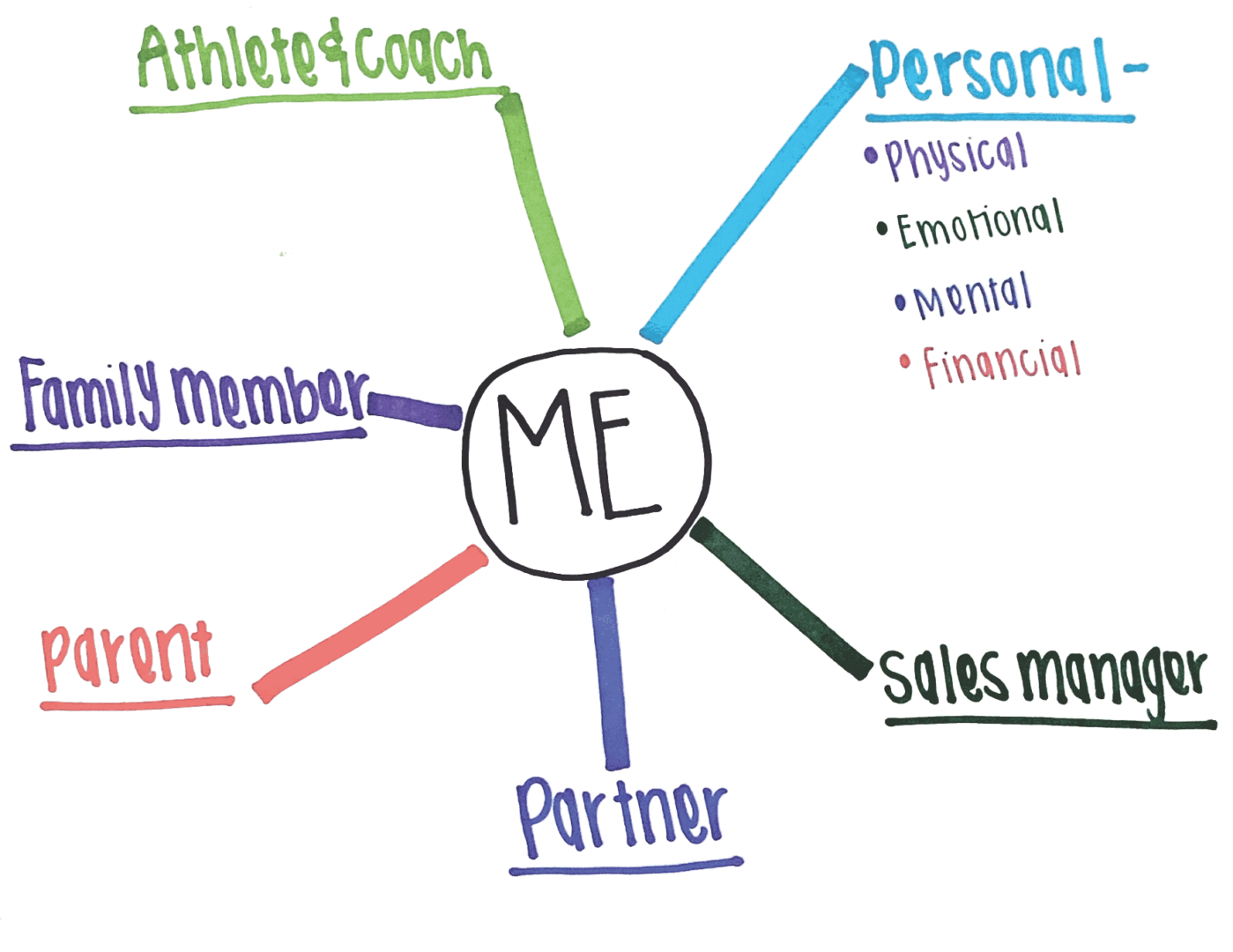
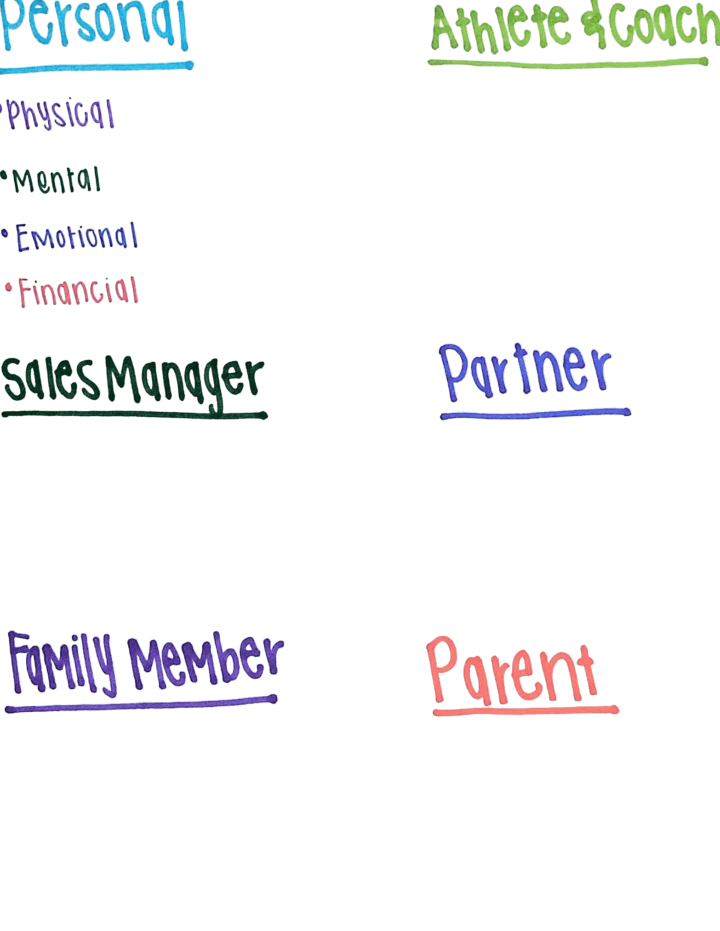
And now (drumroll) … it’s your turn!
You can now create your final vision board! You have everything you need.
You have your (1) key roles, your (2) key vision statement, and your (3) layout, so it should be easy to find pictures that capture the essence of your vision sentence for each role. You can use personal pictures, google images, stock photos, friends images (with permission), drawings, art, etc.
Follow your layout and attach these pictures to a posterboard, pegboard, cut piece of wood, whatever you like.
Be creative! Have fun! And, most importantly, capture your fullest potential and wildest hopes and ambitions with the pictures you compile! Here’s the example continued:

You may choose to print out your vision statements for each role and include them on your vision board (as in the example below), or you may choose to leave them off. That choice is up to you. We will say though, that words too have power, and it’s wonderful to have the combined power of pictures and words.
And, here’s some beautiful news, this by no means has to be a static vision board. Your vision and your life path will evolve, gain clarity, and morph. So, get started with where you’re at today, and adjust your roles, vision statements, and pictures as necessary as life moves forward. But, get started today, because this will move your life forward in the right direction and on the right foot.
Step Four – Include Goals (Optional)
So, your vision board can be complete right now. It captures your internal vision – your drive, your ambitions, your hopes, your life direction and life path.
That being said, you may be one of the “goal-oriented” people who want to include goals.
“Why include goals,” you ask? Goals are a plan – a path – for what you can actionably do today to realize your vision.
For example, if you have a “swimmer” role and your vision is to “be an olympic swimmer,” you might set 1-3 SMART goals: “I will be in the pool on average 5x per week this quarter,” and “I will attend 3 olympic development swim camps by the end of this year.” See how those goals create a path to realize the vision?
If you want to include goals, this is a very easy addition. You can start by going back to your paper with each role and your vision for each role. Under each vision statement, simply include 1-3 SMART goals that drive you to achieve your hopes and ambitions. Here’s the example we’ve been using continued:
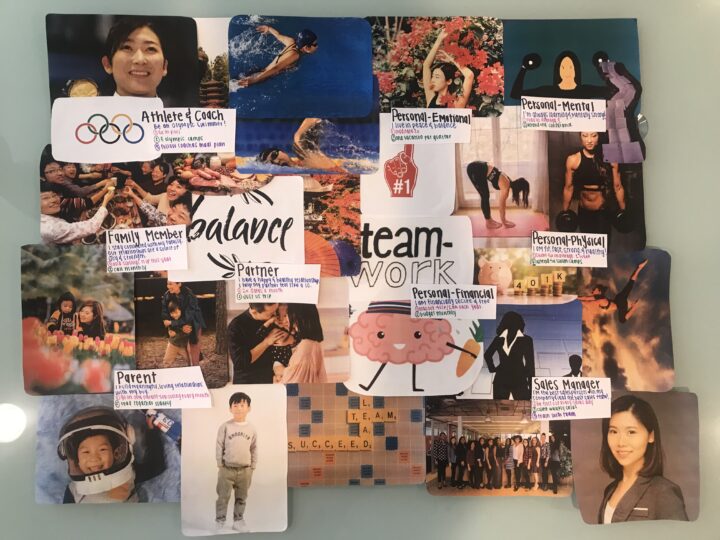
You can see in the above vision board how this person included their goals. Do you like this addition? Would this be motivating for you? If the answer is “yes” and if you’re a goal-minded person, you may wish to do the same. It’s your vision board and your choice. There is no right or wrong.
Bonus Step Five – Take Your Vision To the Weekly & Daily Level
How do you take your vision and goals into your weekly and daily life? This is our area of expertise. The answer is “pre-week planning.” Each week before your week starts, review your vision and goals. Then, write out for each role what you can do – this week – to make those goals a reality. There should be 1-5 action items for each role. Using the swimmer example above, I’d write down the five times (5x) I’d be in the pool. I’d look ahead on my calendar for registrations for swim camps. Would that contribute to my achieving my goals and realizing my vision as a swimmer? Absolutely, no question!
Where do you do this? You may have a physical planner. You can use that. If you don’t and would like one, we offer physical planners built around pre-week planning. If you use google our outlook calendar, you can use a paper to write out your key action items and then add them to your calendar. We also offer a chrome extension that facilitates easy pre-week planning within your google or outlook calendar, if you prefer to keep it strictly digital.
Certainly, this is not required to achieve your goals and realize your vision, but our studies show that it certainly helps. When we track those who pre-week plan, within 4 weeks individuals are accomplishing 30-50% more than when they started pre-week planning. Not only that, they Do What Matters Most – they focus on those actions that unlock potential and drive their vision and goals to reality. Interestingly, 100 percent of study participants say they experience less stress when pre-week planning, even though they are accomplishing more.
This truly is a “high-performance habit,” for those looking to achieve more with less stress.
That’s why we include it here as a bonus step – we want you to have every tool and skill available to realize your vision and achieve your goals.
If helpful, here’s a page that explains pre-week planning and hot to do it: preweekplanning.com
Other Tips, Resources, and Conclusion
Let’s wrap it up!
You now have a vision board. Congratulations! Keep it readily visible, and let it inspire the very best that is in you. This captures your internal vision, your life path, your motivation, your why, and your hopes.
If you’ve added goals, you have articulated a path to realize your vision. Now, go make it happen!
For those who want to take their vision and goals into the weekly and daily level, we invite you to develop the habit of pre-week planning.
Certainly not necessary, but if you’d like additional resources to help you pre-week plan and do what matters most, here are some helpful resources and places to start:
- Take the Personal Productivity Self-Assessment (free)
- Read the book Do What Matters Most
- Invest in an Annual Pre-Week Planning Planner or the Pre-Week Planning Chrome Extension
This is you Becoming Your Best!
Thank you!
“Create the highest grandest vision possible for your life, because you become what you believe.” – Oprah Winfrey
Want to see other articles and posts by Becoming Your Best? Go here.

Episode 426: How to Create a Successful Sales Culture and Change Customers’ Lives for Good!
Tune in to Episode 426 of Becoming Your Best and discover how creating a human-centric sales culture can change your teams and customers’ lives.

Episode 425: More Than Words: Communications Practices of Courageous Leaders with Carrie Fox
Tune in to Episode 425 to unlock the secrets of courageous leadership and discover how to make a meaningful impact in the world, one daring question at a time.

Episode 424: Executive Loneliness: The 5 Pathways to Overcoming Isolation, Stress, Anxiety and Depression
Tune in to Episode 424 to discover how to build safe spaces and connect with those who can help you emerge victorious from executive loneliness’s other side.

